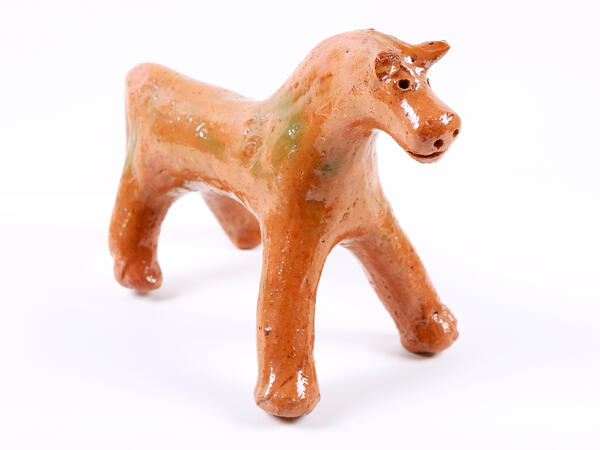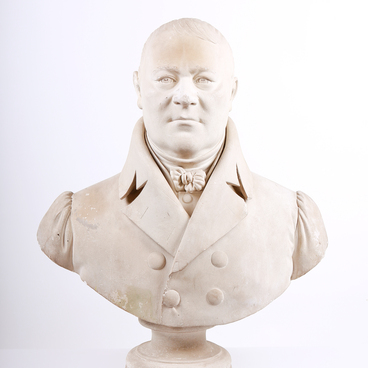Since the beginning of the 19th century, clay toys had been produced in the village of Vyrkovo in the Kasimov district and its surroundings. Pottery was practiced in every Vyrkovo family — by men, women, and children. For example, village boys were taught to work with clay from the age of 11.
The peak of pottery in the village of Vyrkovo happened in the 1930s. Among all the clay products, toys always stood out. They differed in their subjects: some craftsmen sculpted animals, others — fantastic scenes from folklore works. Sometimes the artists turned to genre compositions — scenes of dancing, fights, fair festivities.
Gradually, residents pursued this craft less often. The last Vyrkovo artists, Ivan Listov and Ivan Esin, worked until the 1960s. They created Vyrkovo clay toys commissioned by Russian museums and collectors.
The collection of the Kasimov Historical and Cultural Museum-Reserve contains a Vyrkovo toy made by Ivan Listov. It depicts a brown horse. The author made it out of red clay, which was extracted in the vicinity of the village.
Vyrkovo toys, as well as dishes of local craftsmen, were dried in Russian ovens on frying pans. Then, they were decorated with a light brown glaze — fluent glaze, which was prepared from a mixture of red lead, vitriol, and water. It was difficult to apply the glaze, it often dried in spots, but the natural smudges resembled animals’ mottle. After that, the toys were fired in furnaces — pottery furnaces.
Most of the Vyrkovo toys were whistles that imitated the sounds of animals. For example, a pig figurine made a sound similar to an oinking, and a rooster crowed.
The clay toys created in the village of Vyrkovo were not distinguished by extra elegance. Deliberate rudeness was their special feature. For example, Ivan Listov depicted a brown horse in an unnatural pose: its legs were spread out wide, and the lines of the body were rounded.
By the end of the 20th century, the pottery art in the village of Vyrkovo ceased to exist. Now Vyrkovo toys are displayed at the exhibitions of the Russian Museum in St. Petersburg, the Ryazan State Regional Art Museum named after I. P. Pozhalostin and Kasimov Historical and Cultural Museum-Reserve.
The peak of pottery in the village of Vyrkovo happened in the 1930s. Among all the clay products, toys always stood out. They differed in their subjects: some craftsmen sculpted animals, others — fantastic scenes from folklore works. Sometimes the artists turned to genre compositions — scenes of dancing, fights, fair festivities.
Gradually, residents pursued this craft less often. The last Vyrkovo artists, Ivan Listov and Ivan Esin, worked until the 1960s. They created Vyrkovo clay toys commissioned by Russian museums and collectors.
The collection of the Kasimov Historical and Cultural Museum-Reserve contains a Vyrkovo toy made by Ivan Listov. It depicts a brown horse. The author made it out of red clay, which was extracted in the vicinity of the village.
Vyrkovo toys, as well as dishes of local craftsmen, were dried in Russian ovens on frying pans. Then, they were decorated with a light brown glaze — fluent glaze, which was prepared from a mixture of red lead, vitriol, and water. It was difficult to apply the glaze, it often dried in spots, but the natural smudges resembled animals’ mottle. After that, the toys were fired in furnaces — pottery furnaces.
Most of the Vyrkovo toys were whistles that imitated the sounds of animals. For example, a pig figurine made a sound similar to an oinking, and a rooster crowed.
The clay toys created in the village of Vyrkovo were not distinguished by extra elegance. Deliberate rudeness was their special feature. For example, Ivan Listov depicted a brown horse in an unnatural pose: its legs were spread out wide, and the lines of the body were rounded.
By the end of the 20th century, the pottery art in the village of Vyrkovo ceased to exist. Now Vyrkovo toys are displayed at the exhibitions of the Russian Museum in St. Petersburg, the Ryazan State Regional Art Museum named after I. P. Pozhalostin and Kasimov Historical and Cultural Museum-Reserve.


